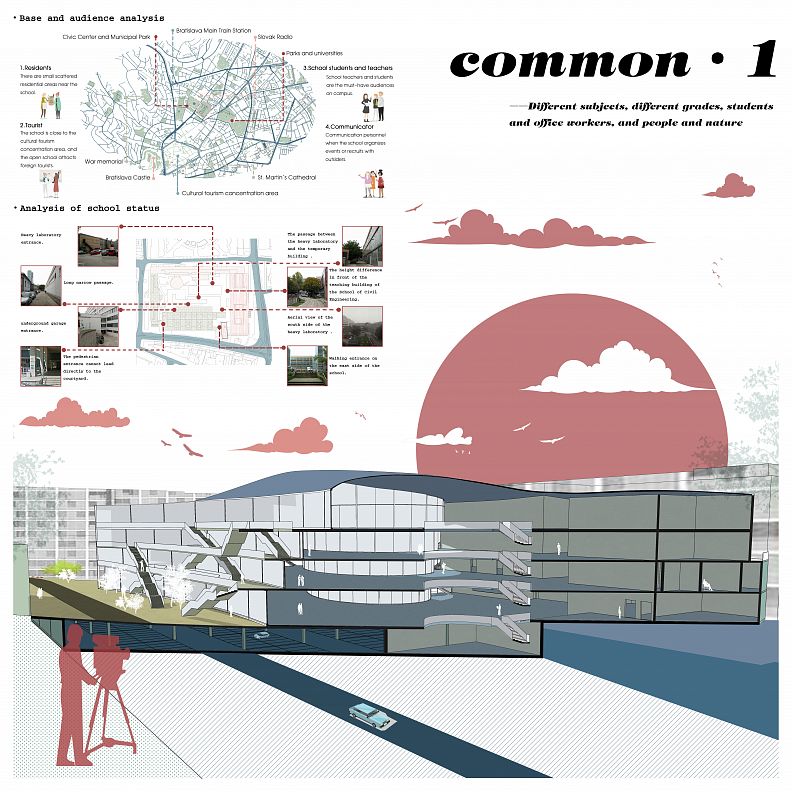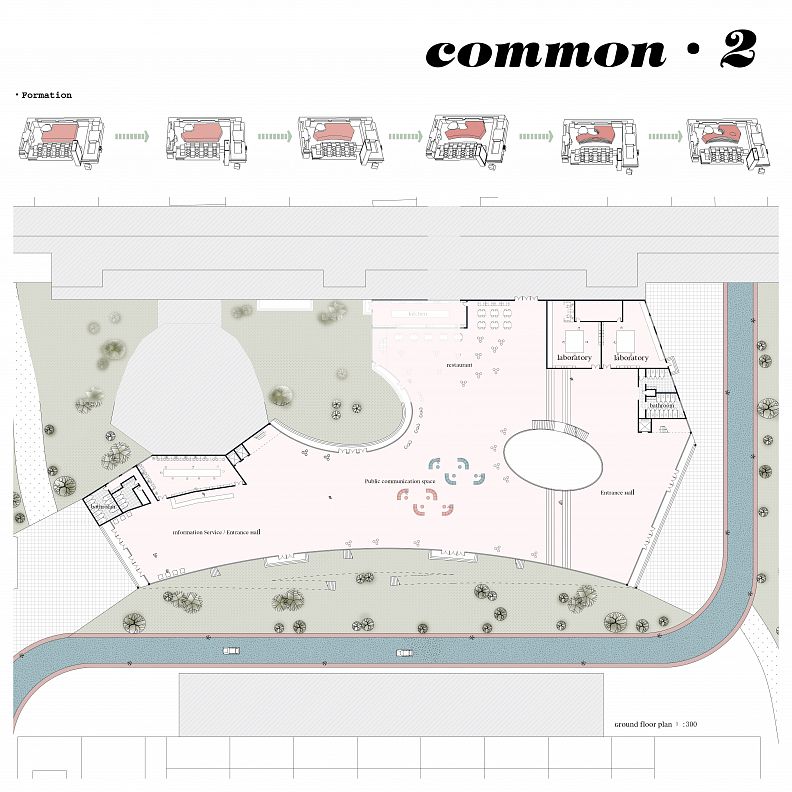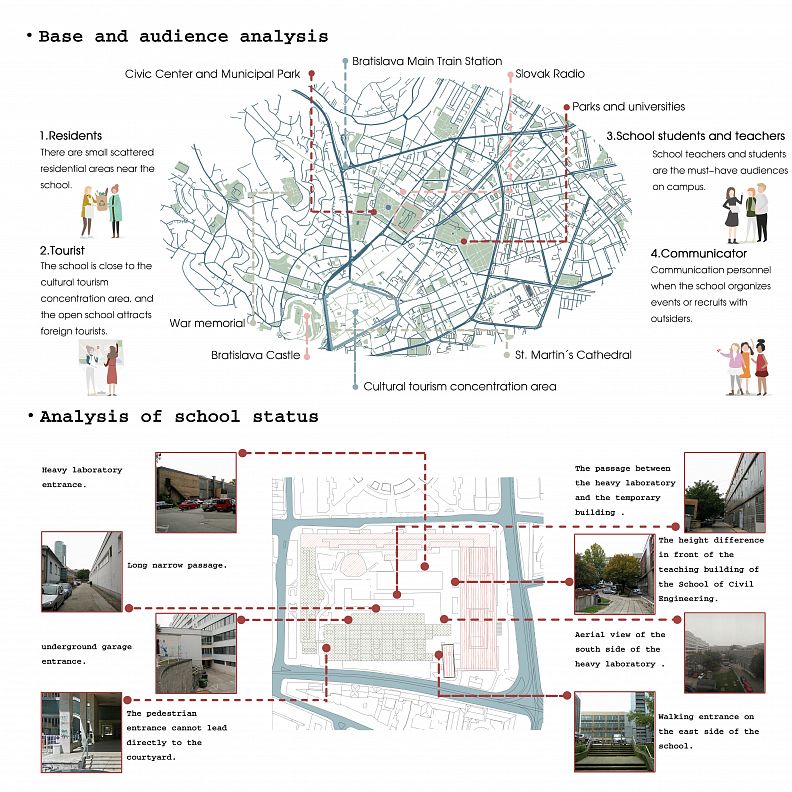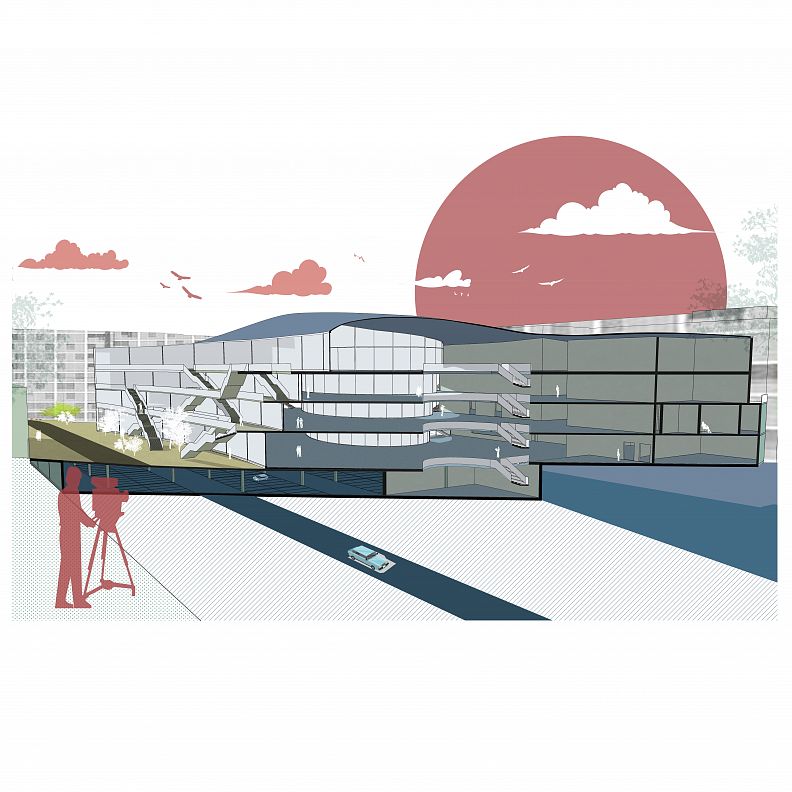common

Idea projektu
The name of the project is common, and its meaning is to create a place for students of different grades and different disciplines to exchange and study, a place for students to communicate with teachers, students and workers, and a place for people and nature to enjoy together.
Popis projektu
The volume of the entire building extends from the teaching building of the School of Mechanical Engineering to the inner courtyard, introducing a small internal natural courtyard. The two ends of the building extend in the direction of the two entrances, and the directions are obvious. The side facing the courtyard uses a large-area curtain wall to enhance the permeability, and the staggered external staircases enhance the richness of the facade. The multi-story stairs are matched with outdoor plants to better cater to the concept of the plan. The indoor space is dominated by a large area of open space, without compulsory division, which is conducive to communication.
Technické informace
5.1.3 The fire resistance rating of civil buildings should be determined according to their building height, use function, importance and difficulty of fire fighting, etc., and should meet the following requirements:
1 The fire resistance rating of underground or semi-underground buildings (rooms) and first-class high-rise buildings shall not be lower than Class I;
2. The fire resistance rating of single and multi-storey important public buildings and second-class high-rise buildings shall not be lower than second-class.
5.1.3A Except for wood-structured buildings, the fire resistance rating of care facilities for the elderly shall not be lower than Class III.
5.1.4 For civil buildings with a building height greater than 100m, the fire resistance rating of the floor slab shall not be less than 2.00h.
For the flat roofs of buildings with Class I and II fire resistance, the fire resistance rating of the roof panels shall not be less than 1.50h and 1.00h respectively.
5.1.5 Non-combustible materials should be used for the roof panels of buildings with Class I or II fire resistance.
Non-combustible and non-combustible materials should be used for the roof waterproofing layer. When combustible and non-combustible materials are used, the waterproof material or combustible and non-combustible thermal insulation materials should be used as the protective layer.
5.1.6 Room partition walls with flame-retardant walls in buildings with Class II fire resistance shall have a fire resistance rating of not less than 0.75h; when the building area of the room is not greater than 100m2, the room partition wall may be adopted with a fire resistance rating of not less than 0.50h non-combustible wall or non-combustible wall with fire resistance rating not less than 0.30h.
The fire resistance rating of the prestressed reinforced concrete floor slab used in the second-class fire resistance multi-storey residential building shall not be less than 0.75h.
5.1.7 For non-load-bearing exterior walls, room partition walls and roof panels in buildings, when metal sandwich panels are really required, their core materials should be non-combustible materials, and the fire resistance limit should comply with the relevant provisions of this code.
5.1.8 The ceiling of non-combustible materials used in buildings with Class II fire resistance has no limit on fire resistance.
Non-combustible materials should be used in the ceilings of medical buildings with Class III fire resistance, teaching buildings in primary and secondary schools, care facilities for the elderly, nurseries, children’s rooms in kindergartens, and children’s playgrounds, etc.; non-combustible materials should be used; The fire resistance limit should not be less than 0.25h.
Non-combustible materials should be used for the suspended ceilings of the halls and walkways in buildings with Class II and Class III fire resistance.
5.1.9 The exposed parts of the joints of prefabricated reinforced concrete members in the building shall be protected against fire, and the fire resistance rating of the joints shall not be lower than the fire resistance rating of the corresponding members.
3.0.1 The construction area of the building shall be calculated as the sum of the horizontal area of the outer wall structure of the natural floor. If the structural storey height is 2.20m and above, the full area shall be calculated; if the structural storey height is below 2.20m, the 1/2 area shall be calculated.
3.0.2 When there are partial floors in a building, for the second and above floors of the partial floors, those with an enclosure structure shall be calculated according to the horizontal area of the outer surrounding structure, and those without an enclosure structure shall be calculated according to the horizontal area of the structural floor Calculation. If the structural storey height is 2.20m and above, the total area shall be calculated; if the structural storey height is below 2.20m, the area shall be calculated as 1/2.
3.0.3 For the sloping roof forming the building space, the total area of the part with the structural net height of 2.10m and above shall be calculated; the part with the structural net height of 1.20m and above to 2.10m shall be calculated as 1/2 area; the net structure The building area shall not be calculated for the part whose height is less than 1.20m.
3.0.4 For the building space under the stands of the stadium, the area with a clear structural height of 2.10m and above shall be calculated as the full area; the area with a clear structural height of 1.20m and above to 2.10m shall be calculated as 1/2 area; the structural net The building area shall not be calculated for the parts with height below 1.20m. For the cantilevered stands with enclosures set up separately indoors, the building area should be calculated according to the horizontal projection area of the stand structure bottom plate. The area of the grandstand with a roof and no enclosure structure shall be calculated based on 1/2 of the horizontal projection area of the roof.
3.0.5 The basement and semi-basement shall be calculated according to the horizontal area of the outer structure. If the structural storey height is 2.20m and above, the total area shall be calculated; if the structural storey height is below 2.20m, the area shall be calculated as 1/2.
3.0.6 The area of the ramp on the outer wall of the entrance and exit with a roof shall be calculated according to 1/2 of the horizontal area of the outer wall structure.
3.0.7 The building area should be calculated according to the horizontal projection of the roof of the overhead floor of the building and the overhead floor of the sloping building. If the structural storey height is 2.20m and above, the full area shall be calculated; if the structural storey height is below 2.20m, the 1/2 area shall be calculated.
3.0.8 The building area of the foyer and hall of the building should be calculated on the basis of the first floor, and the hallway and the corridor set in the hall should be calculated according to the horizontal projection area of the corridor structure bottom plate. If the structural storey height is 2.20m and above, the total area shall be calculated; if the structural storey height is below 2.20m, the area shall be calculated as 1/2.
3.0.9 For the overhead corridors between buildings, if there is a roof and enclosure structure, the total area should be calculated according to the horizontal area of the enclosure structure; if there is no enclosure structure or with enclosure facilities, it should be projected horizontally according to its structural floor The area is calculated as 1/2 area.





